Soils
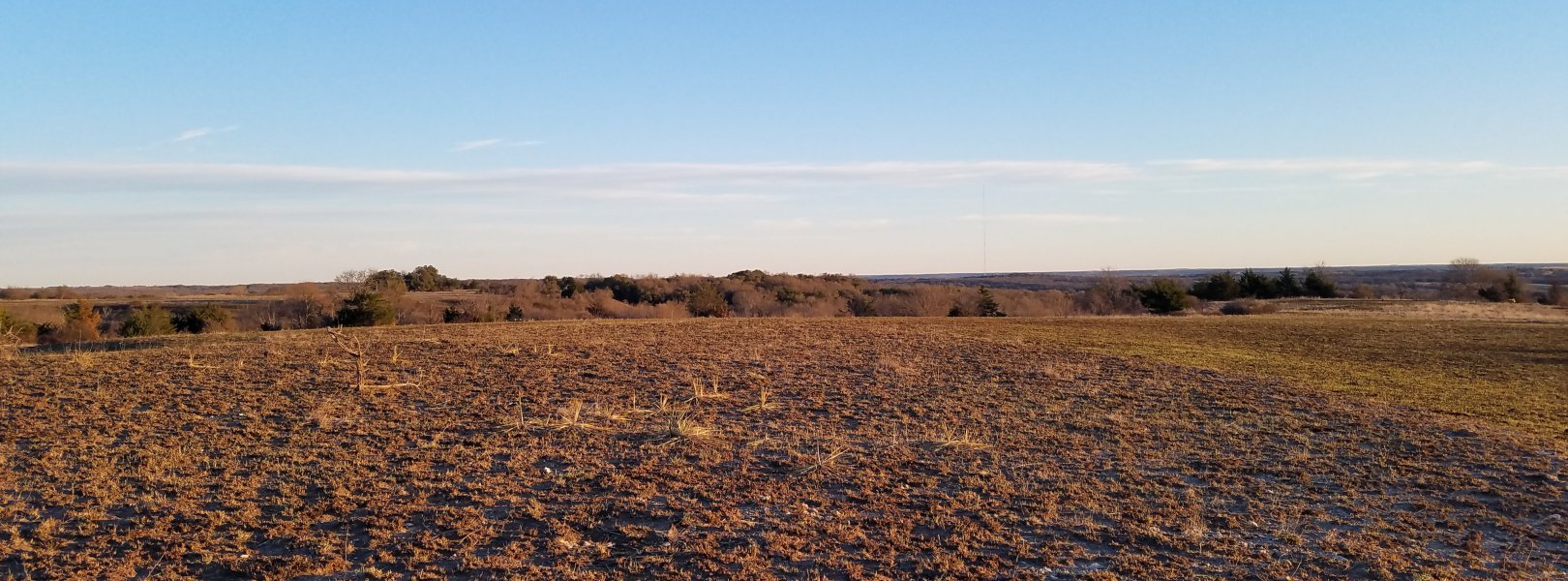
Soils play a critical role in terrestrial ecosystem function. They provide the nutrients and water needed to support plant growth, and they store more than twice as much carbon as the atmosphere. They are also home to a tremendous diversity of microorganisms and soil fauna. Given the rapidly increasing pace of global change and the increasing focus on soil health as a key ecosystem service, it is crucial to monitor changes in soil carbon, nutrient concentrations, and cycling rates as well as the composition, abundance, and functional potential of soil organisms.
NEON terrestrial soil monitoring encompasses both observational sampling across spatial and temporal scales as well as in situ continuous sensor measurements in the vicinity of NEON towers. Together, these provide estimates of key physical, chemical, and biological soil properties across all NEON terrestrial sites. Observational sampling includes a suite of initial soil characterization efforts as well as periodic measurements.
For more on key research topics surrounding soils in global change, and on how NEON data can contribute, check out this video.
Sampling Design and Methods
Integrated sampling designs
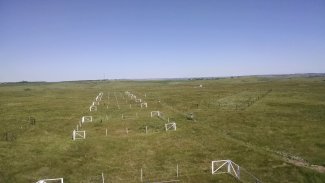
Soil array at the NOGP field site
Soil observational sampling at NEON terrestrial field sites occurs in close proximity to organismal sampling and within the airshed of the instrumented towers, with the goal of allowing connectivity between atmospheric, aboveground, and belowground measurements. Biotic and abiotic elements of soil affect the movement and availability of water and elements across ecosystems, determine the availability of nutrients to vegetation and organisms, and play a central role in the global carbon cycle.
Initial soil characterization
During site construction of all terrestrial field sites, NEON collected soil from each horizon at a single, temporary soil pit, called the "Megapit." Megapit soil samples characterize the soil conditions at the time of site construction. The pit was located in the locally dominant soil type, near the meteorological tower (or flux tower), and was selected to be broadly representative of the soil sensor locations. Megapits were generally 2 m deep and root biomass was measured along with soil physical and chemical properties. In addition to the Megapits, NEON collected soil pit samples from a number of 1 m deep pits distributed throughout the site for a one-time characterization of site-wide soil properties. For both efforts, NEON worked with the U.S. Department of Agriculture (USDA), Natural Resources Conservation Service (NRCS), and the Kellogg Soil Survey Laboratory to assess soil taxonomy and perform a suite of chemical and physical analyses on each soil sample.
Access NEON's Soil Descriptions
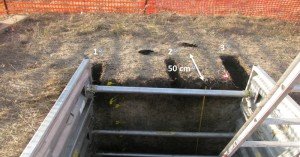
Megapit soil pit at the CPER field site
Sample analysis methods
NEON worked with the USDA-NRCS Kellogg Soil Survey Laboratory to perform a suite of chemical and physical analyses on each soil horizon collected during Megapit and distributed characterization sampling. This includes analysis of texture, bulk density, carbon, nutrients, cation exchange capacity, metals, and more. Results of these characterization analyses and other relevant information about the methods used are documented in the data product tables and data product user guides. Intact blocks of soil collected from the Megapits were used to develop soil-specific corrections for the soil moisture sensors and to determine CO2 diffusivity at a range of soil moistures.
Soil Archiving
Soils from both the Megapits and distributed initial characterization efforts are available upon request to support community research. For Megapit samples, NEON archives a total of 1.2 to 3.6 kg of soil from each horizon. The amount of material archived is variable for distributed initial characterization soils.
Periodic soil sampling
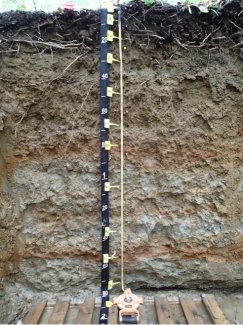
Soil profile in the Megapit soil pit at the SERC field site
Every year, field technicians collect soil cores from plots in the Tower airsheds as well as plots distributed across the landscape in each terrestrial site. Plots are split into four quadrants: three are randomly selected for sampling during each bout, then one soil sample is collected per quadrant. Most years, only the top horizon is sampled (organic or mineral), and cores are sampled up to 30 cm depth or the end of the horizon. This depth was chosen to capture dynamics in the topsoil along with the upper layers of the subsoil or B horizon, and to match the sampling depth used in the Root biomass and chemistry, periodic data product (DP1.10067.001).
Most sites have three sampling bouts per year timed to capture seasonal transitions and peak greenness, the exception being Alaska sites which only sample during peak greenness. Annual measurements include soil moisture, temperature, pH, microbial biomass, and community composition. All sites send several frozen samples to the NEON Biorepository per bout for storage to support community research.
Every five years, a suite of soil biogeochemical measurements is made during the regular sampling bouts. This includes in situ estimates of net nitrogen transformation rates as well as total organic carbon, nitrogen, and C and N stable isotopes. If both organic and mineral horizons are present, both are sampled during these bouts, to a total depth of 30 cm depth or bedrock. A separate sampling campaign is used to collect soil cores for root biomass estimates in Tower plots on the same frequency of every five years. More information is available on how root measurements and soil measurements fit into the overall NEON biogeochemistry design.
Data Products
Basic soil data related products include:
- Soil physical and chemical properties, Megapit (DP1.10096.001)
- Soil physical and chemical properties, distributed initial characterization (DP1.10047.001)
- Soil physical and chemical properties, distributed periodic (DP1.10086.001)
Archival Samples
Archival soil samples collected from NEON terrestrial field sites are available from the NEON Biorepository. Specimen collection of archive samples may occur annually or once every five years, in tandem with the coordinated measurements of carbon and nutrient cycling. Both organic and mineral horizons are archived, if present at the site location.
| Types of Samples | Storage Condition | Storage Container | Quantity Archived (Annually) † | Expected Sampling Frequency | Link to the Collection |
|---|---|---|---|---|---|
| Soil, air-dried | dry | 250 mL glass jars | 350 to 450 samples | only collected at sites performing coordinated bouts | Soil Collection (Distributed Periodic) (NEON-SOIC-DP) |
| Soil, frozen | -80 °C or -196 °C | 2 oz WhirlPak, 50 mL conical tubes, or 5 mL cryovials | 19,000 to 21,000 samples | annually at all terrestrial sites | Soil Microbe Collection (Bulk Subsamples) (NEON-SOMC-BS) |
| Genomic extracts, from soils | -80 °C | 96-well plates‡ | 2,300 to 3,000 extracts | annually at all terrestrial sites | Soil Microbe Collection (DNA Extracts) (NEON-SOMC-DNA) |
| Megapit and distributed initial characterization soils | Ambient temperature | glass jars | 1.2 or 3.6 kg; each horizon | once | NEON/University of Michigan |
† Quantities represented in this table are annual quantities expected from sampling conducted throughout the observatory during full Operations. Actual quantities may differ from these projections
‡ Quantities are number of samples (not number of well plates); up to 96 samples are contained on the same well plate
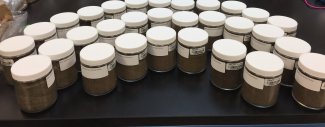
Terrestrial soil samples